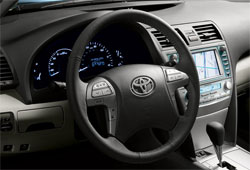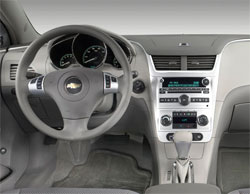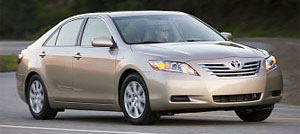2009 Toyota Camry Hybrid vs. 2009 Chevrolet Malibu Hybrid
Hybrid is the biggest buzz-word in the auto industry today, and to many consumers it sounds like magic, promising amazing fuel economy without compromise. So, let’s suppose that you want a hybrid family sedan. Where do you start? What kind of hybrid technology is available? And, are they worth the cost? We’ll try and answer those questions with a tale of two hybrid mid-size sedans, to see if either is ready for a spot in your garage.
Let’s compare the 2009 Toyota Camry Hybrid and the 2009 Chevrolet Malibu Hybrid. But bear in mind, this is not quite an apples-to-apples comparison. The Camry is a “full” gasoline-electric hybrid, while the Malibu is a “mild” hybrid.
A “full” hybrid can run solely on electric power at low speeds. A “mild” hybrid primarily uses its electric motor to shutdown and quickly restart the gas engine at stops to reduce wasteful idling. Any power boost is small.
Both of our hybrids are aimed at optimizing fuel economy in urban traffic. So, besides the start/stop feature, they each also share regenerative braking that keeps the batteries charged. Along with the smaller Prius, the Camry Hybrid is a big part of Toyota’s Hybrid Synergy drive juggernaut.
In Camry the system combines a 105 kilowatt electric motor and a 2.4-liter four cylinder gas engine for a net total of 187 horsepower. Power reaches the road through a Continuously Variable Transmission. Camry Hybrid Government Fuel Economy ratings are 33 city/34 highway with a combined rating of 34 miles-per-gallon. Our Camry Hybrid managed 32.2 miles-per-gallon in mixed driving.
By comparison, the base four-cylinder, automatic Camry LE has a combined rating of 25 miles-per-gallon. So, the Camry Hybrid rates 9 miles-per-gallon, or 36% more efficient than a non-hybrid Camry.
 With high fuel economy comes a low Energy Impact Score of just 10.1 barrels of oil consumed per year, while the Carbon Footprint comes in at a small 5.4 annual tons of CO2 emitted.
With high fuel economy comes a low Energy Impact Score of just 10.1 barrels of oil consumed per year, while the Carbon Footprint comes in at a small 5.4 annual tons of CO2 emitted.
Another plus for a “full” hybrid is acceleration. On the track, our Camry Hybrid tester moved from 0 to 30 in 3.2 seconds and 0 to 60 in 8 seconds flat. While there was some conflict between electric and gas power during full throttle launches, overall performance is comparable to a gas V6.
Inside, the Camry Hybrid touts a formal, well equipped cabin, with upgrades such as dual-zone climate control, over the Camry LE.
The biggest hybrid difference is in the gauge cluster, where a screen inside the speedometer that shows how the hybrid system is operating. Arrows indicate the flow of energy between components and the wheels. To the left is an analog gauge for instantaneous miles-per-gallon.
Now let’s turn to the Chevrolet Malibu Hybrid, the most fuel efficient version of General Motor’s most acclaimed new car design in decades. For the Malibu Hybrid, GM’s 2.4-liter Ecotec 4-cylinder engine gains a hang-on electric motor/starter/generator that provides 10 kilowatts of power through a straight forward belt and pully system routed to the gas engine’s crank. Total output is 164 horsepower, managed by a four-speed automatic transmission.
Government Fuel Economy ratings for the Malibu Hybrid are 26 city/34 highway with a combined rating of 29 miles-per-gallon. Our tester achieved 29.5 miles-per-gallon in real-world driving. A base four-cylinder Malibu automatic has a combined rating of 25 miles-per-gallon. So, the Malibu Hybrid has an advantage of 4 miles-per-gallon or 16% gain. The Energy Impact Score is a modest 11.8 barrels of oil consumed per year, while the Carbon Footprint measures only 6.3 annual tons of CO2 emitted.
In terms of performance, our Malibu tester ran from 0 to 30 in 3.7 seconds and 0 to 60 in 10 seconds even. Without a substantial electric motor boost, that’s a 2 full seconds slower than the Camry Hybrid.
 On the inside, the Malibu Hybrid displays a sporty, well appointed twin-cockpit style dash. The hybrid is a step above LT trim adding automatic climate control.
On the inside, the Malibu Hybrid displays a sporty, well appointed twin-cockpit style dash. The hybrid is a step above LT trim adding automatic climate control.
For efficiency info, there’s a simple “Eco” light, instant fuel economy readout, as well as a Hybrid Charge/Assist gauge. Just keep the needle pointed directly to your right for optimum operation.
Okay, so which hybrid makes sense? In miles-per-gallon, the Camry managed 32.2 over the Malibu’s 29.5. That’s a 10% edge for the Camry. The Camry’s carbon footprint is about 18 percent smaller than the Malibu’s, and it has better acceleration. So, the Camry is clearly the more ecological choice.
But when it comes to cost, the tide changes. The Malibu Hybrid’s base price of $25,345 is $1,525 less than the Camry Hybrid’s $26,870. Plus, the Malibu qualifies for a $1,300 hybrid tax credit that has expired for the Camry.
That puts the Malibu’s cost advantage at over $2,800. Base on our test mileage, using $4 a gallon gas, one would have to drive the Camry Hybrid 250,000 miles before it would be a better dollar value than Malibu Hybrid. But if gas goes higher, the Camry will payback faster.
Still, both cars are headed in the right direction. Well-designed 5-passenger hybrid sedans that fit the mainstream American lifestyle. One is a more green to drive, while the other takes less green to drive home. So, “full hybrid” or “mild hybrid,” we say buy what you can afford! Either way you will save on gas, and know that you’ve made a choice that will benefit all of us.
Specifications
- Camry Engine: "full" Hybrid105 Kilowatt Electric Motor2.4-Liter 4-Cylinder
- Horsepower: 164
- 0-60 MPH: 10.0 Seconds
- EPA: 26 MPG City/ 34 MPG Highway
- Mixed Loop: 29.5 MPG
- Energy Impact: 11.8 Barrels Oil/Yr
- CO2 Emissions: 6.3 Tons/Yr
- Malibu Engine: "mild" Hybrid10 Kilowatt Electric Motor2.4-Liter Ecotec 4-Cylinder






